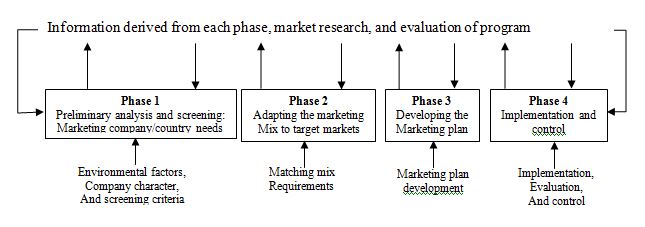Executive Summary
Doing business is increasingly global in extent today. There are several reasons for this. One significant reason is technological – because of improved transportation and communication opportunities today, trade is now more practical.
Increasingly rapid technology lifecycles also increases the competition among countries as to who can produce the newest technological product. Trade between countries is beneficial because these countries differ in their relative economic strengths-some have more advanced technology and some have lower costs.On the basis of these realities, business need to proper international marketing plan for distribute the product through globally.
1.0 Introduction
Planning is a systematized way of relating to the future. It is an attempt to manage the effects of external, uncontrollable factors on the firm’s strengths, weaknesses, objectives, and goals to attain a desired end. Further, it is a commitment of resources to a country market to achieve specific goals. In other words, planning is the jobs of making things happen that may not otherwise occur.
Planning relates to the formulation of goals and methods of accomplishing them, so it is both a process and a philosophy. Structurally, planning may be viewed as corporate, strategic, and/or tactical. International corporate planning is essentially long-term, incorporating generalized goals for the enterprise as a whole. Strategic planning is conducted at the highest levels of management and deals with products, capital, and research, and long-and short-term goals of the company. Tactical planning, or market planning, pertains to specific actions and to the allocation of resources used to implement strategic planning goals in specific markets. Tactical plans are made at the local level and address marketing and advertising questions.
2.0 Evolution to global marketing
Global marketing is not a revolutionary shift, it is an evolutionary process. While the following does not apply to all companies, it does apply to most companies that begin as domestic-only companies.
2.1 Domestic marketing
A marketing restricted to the political boundaries of a country, is called “Domestic Marketing”. A company marketing only within its national boundaries only has to consider domestic competition. Even if that competition includes companies from foreign markets, it still only has to focus on the competition that exists in its home market. Products and services are developed for customers in the home market without thought of how the product or service could be used in other markets. All marketing decisions are made at headquarters.
The biggest obstacle these marketers face is being blindsided by emerging global marketers. Because domestic marketers do not generally focus on the changes in the global marketplace, they may not be aware of a potential competitor who is a market leader on three continents until they simultaneously open 20 stores in the Northeastern U.S. These marketers can be considered ethnocentric as they are most concerned with how they are perceived in their home country.
2.2 Export marketing
Generally, companies began exporting, reluctantly, to the occasional foreign customer who sought them out. At the beginning of this stage, filling these orders was considered a burden, not an opportunity. If there was enough interest, some companies became passive or secondary exporters by hiring an export management company to deal with all the customs paperwork and language barriers. Others became direct exporters, creating exporting departments at headquarters. Product development at this stage is still focused on the needs of domestic customers. Thus, these marketers are also considered ethnocentric.
2.3 International marketing
If the exporting departments are becoming successful but the costs of doing business from headquarters plus time differences, language barriers, and cultural ignorance are hindering the company’s competitiveness in the foreign market, then offices could be built in the foreign countries. Sometimes companies buy firms in the foreign countries to take advantage of relationships, storefronts, factories, and personnel already in place. These offices still report to headquarters in the home market but most of the marketing mix decisions are made in the individual countries since that staff is the most knowledgeable about the target markets. Local product development is based on the needs of local customers. These marketers are considered polycentric because they acknowledge that each market/country has different needs.
2.4 Multinational marketing
At the multi-national stage, the company is marketing its products and services in many countries around the world and wants to benefit from economies of scale. Consolidation of research, development, production, and marketing on a regional level is the next step. An example of a region is Western Europe with the US. But, at the multinational stage, consolidation, and thus product planning, does not take place across regions; a regioncentric approach.
2.5 Global marketing
When a company becomes a global marketer, it views the world as one market and creates products that will only require weeks to fit into any regional marketplace. Marketing decisions are made by consulting with marketers in all the countries that will be affected. The goal is to sell the same thing the same way everywhere.
3.0 International marketing planning process

3.1 Preliminary analysis and screening
At this stage one takes a more serious look at those countries remaining after undergoing preliminary screening. Now you begin to score, weight and rank nations based upon macro-economic factors such as currency stability, exchange rates, level of domestic consumption and so on. Now you have the basis to start calculating the nature of market entry costs. Some countries such as China require that some fraction of the company entering the market is owned domestically – this would need to be taken into account. There are some nations that are experiencing political instability and any company entering such a market would need to be rewarded for the risk that they would take. At this point the marketing manager could decide upon a shorter list of countries that he or she would wish to enter. Now in-depth screening can begin.
3.1.1 Company character
The next step is to identify the company’s character. These criteria are ascertained by an analysis of company objectives, resources, and other corporate capabilities and limitations. A company’s commitment to international business and its objective for going international are important is establishing evaluation criteria. Minimum market potential, minimum profit, return on investment, acceptable competitive levels, standards of political stability.
3.1.2 Home-Country constraints
In this step the marketing plan need to classify the home country restraints. They are like, political and legal forces, economic climate, completive structure. These include home-country restraints can have a direct effect on the success of a international business.
3.1.3 Host-country(s) constraints
In this step the marketing plan require to classify the host-country(s) limitations as like the home countries. Host-country(s) constraints are more that the home country’s. They are: Political/legal forces, cultural forces, geography and infrastructure, structure of distribution, level of technology, competitive forces, economic forces.
3.3 Developing the marketing plan
At this stage of the planning process, a marketing plan is developed for the target market – whether it is a single country or a global market set.
3.3.1 Situation analysis
The marketing plan begins with a situation analysis. A situation analysis is the foundation of the strategic planning process for international marketing plan. It includes an examination of both the internal factors (to identify strengths and weaknesses) and external factors (to identify opportunities and threats).
3.3.2 Objective and goals
At this section the marketing plan need to select their objective, like what is to be done, by whom, how it is to be done, and when. . A company’s commitment to international business and its objective for going international are important is establishing evaluation criteria. Minimum market potential, minimum profit, return on investment, acceptable competitive levels, standards of political stability.
Goal-setting ideally involves establishing specific, measurable and time-targeted objectives. Work on the theory of goal-setting suggests that it can serve as an effective tool for making progress by ensuring that participants have a clear awareness of what they must do to achieve or help achieve an objective. On a personal level, the process of setting goals allows people to specify and then work towards their own objectives — most commonly financial or career-based goals. Goal-setting comprises a major component of Personal development.
3.3.3 Strategy and tactics
The marketer needs to determine possibilities for applying marketing tactics across national markets. The search for similar segments across countries can often lead to opportunities for economies of in marketing programs.
3.3.4 Selecting mode of entry
Selecting the mode of entry with rare exceptions, products just don’t emerge in foreign markets overnight—a firm has to build up a market over time. Several strategies, which differ in aggressiveness, risk, and the amount of control that the firm is able to maintain.
3.3.5 Budgets
Budgeting is the main formal control methods. The budget spells out the objectives and necessary expenditures to achieve these objectives. Included are budgets and sales and profit expectations. Control consists of measuring actual sales against expenditures. If there is tolerable variance then no action is usually taken.
3.3.6 Action programs
After the completing the phase 3, a decision not to enter a specific market may be made if it is determined that company marketing objectives and goals cannot be met. Performance is evaluated by measuring actual against planned performance. The problem is setting a performance standard. Finally when marketers are see the plan would be success then they apply the plan for international business. Otherwise they stop the plan at this phase 3.
4.4 Implementation and control
At this stage when Phase 3 decision will be “go” then Phase 3 actives implementation of specific plans and anticipation of successful marketing. However, the planning process does not end at this point. All marketing plans need coordination and control during the period of implementation. Many businesses don’t control marketing plans as thoroughly as they could even though continuous monitoring and control could increase their success.
4.4.1 Objectives
The evaluation and control system requires performance – objective action, that is, bringing the plan back on track should standards of performance fall short.
4.4.2 Standards
In the global orientation the marketer need to maintain the internationally standard to stable in the international market.
4.4.3 Assign responsibility
As a company expands in to more foreign markets with several products, it becomes more difficult to efficiently manage all products across all markets. Therefore they need to allocate liability for their international business.
4.4.4 Measure performance
4.4.5 Correct for error
Consumers and businesses now have access to the very best products from many different countries. Increasingly rapid technology lifecycles also increases the competition among countries as to who can produce the newest in technology. In part to accommodate these realities, countries in the last several decades have taken increasing steps to promote global trade through agreements such as the General Treaty on Trade and Tariffs, and trade organizations such as the World Trade Organization (WTO), North American Free Trade Agreement (NAFTA), and the European Union (EU).
4.2 Adapting the marketing mix to target markets
The “Four P’s” of marketing: product, price, placement, and promotion are all affected as a company moves through the five evolutionary phases to become a global company. Ultimately, at the global marketing level, a company trying to speak with one voice is faced with many challenges when creating a worldwide marketing plan. Unless a company holds the same position against its competition in all markets (market leader, low cost, etc.) it is impossible to launch identical marketing plans worldwide.
4.2.1 Product
A global company is one that can create a single product and only have to tweak elements for different markets. For example, Coca-Cola uses two formulas (one with sugar, one with corn syrup) for all markets. The product packaging in every country incorporates the contour bottle design and the dynamic ribbons in some way, shape, or form. However, the bottle or can also includes the country’s native language and is the same size as other beverage bottles or cans in that country.

4.2.2 Price
Price will always vary from market to market. Price is affected by many variables: cost of product development (produced locally or imported), cost of ingredients, cost of delivery (transportation, tariffs, etc.), and much more. Additionally, the product’s position in relation to the competition influences the ultimate profit margin. Whether this product is considered the high-end, expensive choice, the economical, low-cost choice, or something in-between helps determine the price point.
4.2.3 Promotion
After product research, development and creation, promotion (specifically advertising) is generally the largest line item in a global company’s marketing budget. At this stage of a company’s development, integrated marketing is the goal. The global corporation seeks to reduce costs, minimize redundancies in personnel and work, maximize speed of implementation, and to speak with one voice. If the goal of a global company is to send the same message worldwide, then delivering that message in a relevant, engaging, and cost-effective way is the challenge.
Effective global advertising techniques do exist. The key is testing advertising ideas using a marketing research system proven to provide results that can be compared across countries. The ability to identify which elements or moments of an ad are contributing to that success is how economies of scale are maximized. Market research measures such as Flow of Attention, Flow of Emotion and branding moments provide insights into what is working in an ad in any country because the measures are based on visual, not verbal, elements of the ad.
4.2.4 Distribution
How the product is distributed is also a country-by-country decision influenced by how the competition is being offered to the target market. Using Coca-Cola as an example again, not all cultures use vending machines. In the United States, beverages are sold by the pallet via warehouse stores. In India, this is not an option. Placement decisions must also consider the product’s position in the market place. For example, a high-end product would not want to be distributed via a “dollar store” in the United States. Conversely, a product promoted as the low-cost option in France would find limited success in a pricey boutique.
International Distribution
Promotional tools. Numerous tools can be used to influence consumer purchases:
- Advertising—in or on newspapers, radio, television, billboards, busses, taxis, or the Internet.
- Price promotions—products are being made available temporarily as at a lower price, or some premium (e.g., toothbrush with a package of toothpaste) is being offered for free.
- Sponsorships
- Point-of-purchase—the manufacturer pays for extra display space in the store or puts a coupon right by the product
- Other method of getting the consumer’s attention—all the Gap stores in France may benefit from the prominence of the new store located on the Champs-Elysees.
Promotional objectives. Promotional objectives involve the question of what the firm hopes to achieve with a campaign—“increasing profits” is too vague an objective, since this has to be achieved through some intermediate outcome (such as increasing market share, which in turn is achieved by some change in consumers which cause them to buy more). Some common objectives that firms may hold:
- Awareness. Many French consumers do not know that the Gap even exists, so they cannot decide to go shopping there. This objective is often achieved through advertising, but could also be achieved through favorable point-of-purchase displays. Note that since advertising and promotional stimuli are often afforded very little attention by consumers, potential buyers may have to be exposed to the promotional stimulus numerous times before it “registers.”
- Trial. Even when consumers know that a product exists and could possibly satisfy some of their desires, it may take a while before they get around to trying the product—especially when there are so many other products that compete for their attention and wallets. Thus, the next step is often to try get consumer to try the product at least once, with the hope that they will make repeat purchases. Coupons are often an effective way of achieving trial, but these are illegal in some countries and in some others, the infrastructure to readily accept coupons (e.g., clearing houses) does not exist. Continued advertising and point-of-purchase displays may be effective. Although Coca Cola is widely known in China, a large part of the population has not yet tried the product.
- Attitude toward the product. A high percentage of people in the U.S. and Europe has tried Coca Cola, so a more reasonable objective is to get people to believe positive things about the product—e.g., that it has a superior taste and is better than generics or store brands. This is often achieved through advertising.
- Temporary sales increases. For mature products and categories, attitudes may be fairly well established and not subject to cost-effective change. Thus, it may be more useful to work on getting temporary increases in sales (which are likely to go away the incentives are removed). In the U.S. and Japan, for example, fast food restaurants may run temporary price promotions to get people to eat out more or switch from competitors, but when these promotions end, sales are likely to move back down again (in developing countries, in contrast, trial may be a more appropriate objective in this category).
Note that in new or emerging markets, the first objectives are more likely to be useful while, for established products, the latter objectives may be more useful in mature markets such as Japan, the U.S., and Western Europe.
Entry Strategies
Methods of entry. With rare exceptions, products just don’t emerge in foreign markets overnight—a firm has to build up a market over time. Several strategies, which differ in aggressiveness, risk, and the amount of control that the firm is able to maintain, are available:
- Exporting is a relatively low risk strategy in which few investments are made in the new country. A drawback is that, because the firm makes few if any marketing investments in the new country, market share may be below potential. Further, the firm, by not operating in the country, learns less about the market (What do consumers really want? Which kinds of advertising campaigns are most successful? What are the most effective methods of distribution?) If an importer is willing to do a good job of marketing, this arrangement may represent a “win-win” situation, but it may be more difficult for the firm to enter on its own later if it decides that larger profits can be made within the country.
- Licensing and franchising are also low exposure methods of entry—you allow someone else to use your trademarks and accumulated expertise. Your partner puts up the money and assumes the risk. Problems here involve the fact that you are training a potential competitor and that you have little control over how the business is operated. For example, American fast food restaurants have found that foreign franchisers often fail to maintain American standards of cleanliness. Similarly, a foreign manufacturer may use lower quality ingredients in manufacturing a brand based on premium contents in the home country.
- Turnkey Projects. A firm uses knowledge and expertise it has gained in one or more markets to provide a working project—e.g., a factory, building, bridge, or other structure—to a buyer in a new country. The firm can take advantage of investments already made in technology and/or development and may be able to receive greater profits since these investments do not have to be started from scratch again. However, getting the technology to work in a new country may be challenging for a firm that does not have experience with the infrastructure, culture, and legal environment.
- Management Contracts. A firm agrees to manage a facility—e.g., a factory, port, or airport—in a foreign country, using knowledge gained in other markets. Again, one thing is to be able to transfer technology—another is to be able to work in a new country with a different infrastructure, culture, and political/legal environment.
- Contract manufacturing involves having someone else manufacture products while you take on some of the marketing efforts yourself. This saves investment, but again you may be training a competitor.
- Direct entry strategies, where the firm either acquires a firm or builds operations “from scratch” involve the highest exposure, but also the greatest opportunities for profits. The firm gains more knowledge about the local market and maintains greater control, but now has a huge investment. In some countries, the government may expropriate assets without compensation, so direct investment entails an additional risk. A variation involves a joint venture, where a local firm puts up some of the money and knowledge about the local market.
5.0 Conclusion
Utilizing the planning process encourages the decision maker to consider all variables that affect the success of a company’s plan. Furthermore, it provides the basis for vewing all country markets and their interrelationships and as an integrated global unit.
Planning permits for rapid growth of the international function, changing markets, increasing competition, and the ever-varying challenges of different national markets. The plan must blend the changing parameters of external country environments with corporate objectives and capabilities to develop a sound, workable marketing program. A strategic plan commits corporate resources to products and markets to increase competitiveness and profits.
6.0 References
Cateora, and Graham, “International Marketing”, 11th Ed, Mc Graw Hill, New York.
http://www.oppapers.com/essays/International-Marketing-Planning-Process/171126
http://en.wikipedia.org/wiki/Global_marketing
http://en.wikipedia.org/wiki/Marketing_plan
http://bazookabiz.com/strategic-marketing/30

Article written by : Asad Saimon















